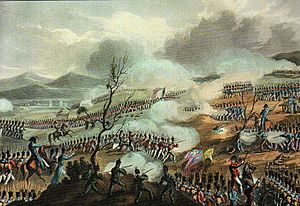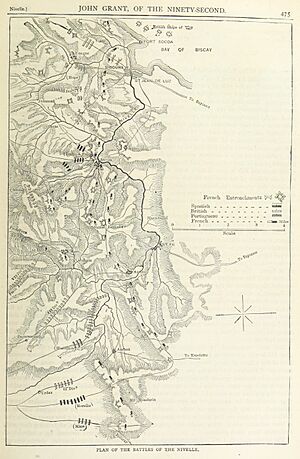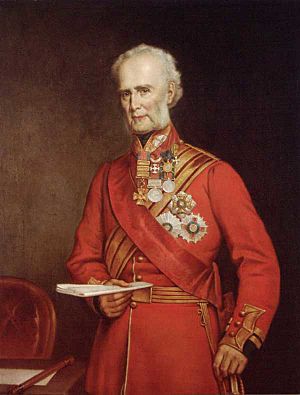Battle of Nivelle facts for kids
Quick facts for kids Battle of Nivelle |
|||||||
|---|---|---|---|---|---|---|---|
| Part of the Peninsular War | |||||||
 Gravure of the battle |
|||||||
|
|||||||
| Belligerents | |||||||
| Commanders and leaders | |||||||
| Strength | |||||||
| 50,000 (18,000 engaged) | 90,000 (50,000 engaged) | ||||||
| Casualties and losses | |||||||
| 3,200 killed or wounded 1,300 captured |
5,300 killed or wounded 200 captured (2,800 Anglo-Portuguese and 2,700 Spanish) |
||||||
The Battle of Nivelle happened on November 10, 1813. It was fought near the Nivelle River in France. This battle was one of the last big fights in the Peninsular War (1808–1814).
After a long fight at San Sebastian, Wellington and his Allied army were chasing Marshal Soult. Wellington had about 80,000 British, Portuguese, and Spanish soldiers. Soult had 60,000 men spread out over 20 miles.
The British Light Division led the attack. Soon, the 3rd Division managed to split Soult's army in half. By early afternoon, Soult's forces were retreating. Wellington's army was in a strong position. Soult lost this battle on French land. He lost 4,500 men, while Wellington lost 5,500.
What Led to the Battle?
In the Siege of San Sebastian, the Allied forces captured the port in early September 1813. This was an important victory.
Then, in the Battle of San Marcial on August 31, Soult tried to help the city. But he failed to break through the Spanish defenses. After this, the French army moved back. They went to defend the Bidassoa River. This river is the border between France and Spain near the coast.
On October 7, the Allied army surprised the French. They crossed the river in the Battle of the Bidassoa. During this fight, the Allies also took over some forts on La Rhune mountain. Both sides lost about 1,600 soldiers in these battles.
Where the Armies Stood
The French army, led by Marshal Soult, was set up along the River Nivelle. The river's path was marked by hills. On these hills, the French had built strong forts and defenses.
Soult's lines stretched for about 20 miles. They went from the Atlantic coast on his right side to the snowy Roncesvalles pass on his left. He only had 50,000 men. This meant his army was spread very thin. He couldn't keep many soldiers back as reserves. This might have changed how the battle turned out.
Soult was trying to move back to his base at Bayonne. His position would get stronger there. But he wasn't fast enough. Wellington's army caught up to him.
The French position was dominated by the Greater Rhune. This was a tall, rocky mountain, almost 3,000 feet high. Below it, separated by a deep valley, was the Lesser Rhune. The French had built three forts along the steep top of the Lesser Rhune. If the British could take these forts, Soult's army would be in great danger. It would open him up to attacks from all sides.
Wellington's plan was to attack along Soult's entire line. But the main attack would be in the middle. If they broke through the center or the French left side, the British could cut off the French right side.
Here's how Wellington planned his attack:
- The British left side would attack the French right. This group was led by Sir John Hope. It included the 1st and 5th Divisions and Freire's Spanish soldiers.
- The main Allied attack would be in the French center. This was led by Beresford. It included the 3rd, 4th, 7th, and Light Divisions.
- On the British right side, attacking the French left, Hill would lead. He had the 2nd and 6th Divisions. They were supported by Morillo's Spanish and Hamilton's Portuguese troops.
Wellington decided to launch the attack on November 10.
The Battle Begins
The battle began just before sunrise. The Light Division moved towards the top of the Greater Rhune mountain. French soldiers had been there, but they had left after a small fight on the River Bidassoa. They were afraid of being cut off from their army.
The goal for this division was to clear out the three forts the French had built. They went down into the valley in front of the Lesser Rhune. There, they waited for the order to attack.
After a signal from a group of cannons, the attack started. Soldiers from the 43rd, 52nd, and 95th Regiments charged the forts. The 17th Portuguese infantry Regiment supported them. This was a risky move, and the men were very tired. But the British surprise and bravery made the French run away. They fled to other forts on different hills.
While the 43rd and 95th were fighting on the Rhune, a very strong star-shaped fort remained. It was on the Mouiz plateau and reached towards the coast. Colborne's 52nd Light Infantry attacked this fort. Riflemen from the 95th helped them.
Again, the French were surprised. The British succeeded. The French soldiers felt like the British had appeared out of nowhere. Fearing they would be trapped, the French soldiers quickly ran away. Colborne took the fort and other trenches without losing a single soldier.
Soon after, the main British attack began. Nine divisions spread out over a five-mile front. When the 3rd division captured the bridge at Amotz, all French resistance broke. Communication between the two halves of Soult's army was now impossible.
The French resistance quickly disappeared. Soon, they were in full retreat. By two o'clock in the afternoon, they were streaming across the Nivelle River. Soult's army had lost 4,500 men. Wellington's army lost 5,500.
Images for kids
See also
 In Spanish: Batalla del Nivelle para niños
In Spanish: Batalla del Nivelle para niños




